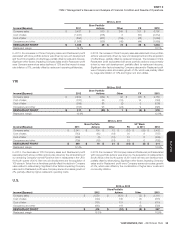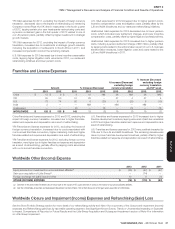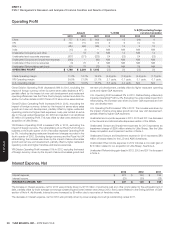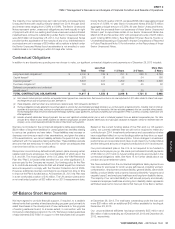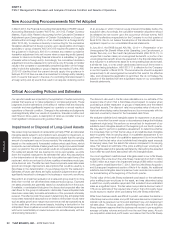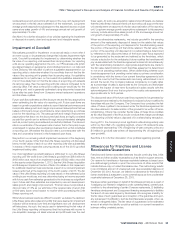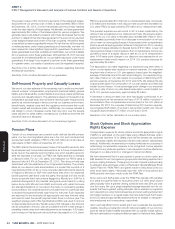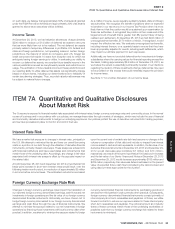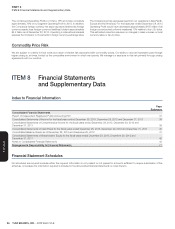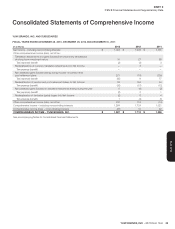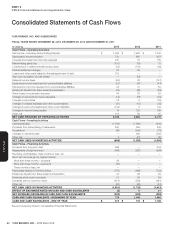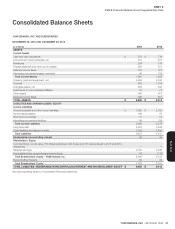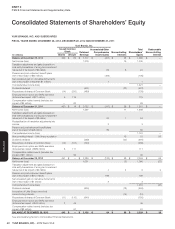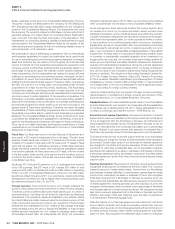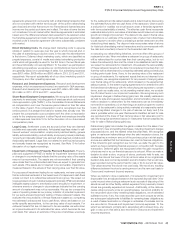Pizza Hut 2013 Annual Report Download - page 131
Download and view the complete annual report
Please find page 131 of the 2013 Pizza Hut annual report below. You can navigate through the pages in the report by either clicking on the pages listed below, or by using the keyword search tool below to find specific information within the annual report.
YUM! BRANDS, INC.-2013 Form10-K 35
Form 10-K
PART II
ITEM7AQuantitative and Qualitative Disclosures About Market Risk
on such data, we believe that approximately 50% of all awards granted
under the RGM Plan will be forfeited and approximately 20% of all awards
granted to above-store executives will be forfeited.
Income Taxes
At December 28, 2013, we had valuation allowances of approximately
$200 million to reduce our $1.0 billion of deferred tax assets to amounts
that are more likely than not to be realized. The net deferred tax assets
primarily relate to temporary differences in profitable U.S. federal and
state and foreign jurisdictions, net operating losses in certain foreign
jurisdictions, the majority of which do not expire, and U.S. foreign tax
credit carryovers that expire 10 years from inception and for which we
anticipate having foreign earnings to utilize. In evaluating our ability to
recover our deferred tax assets, we consider future taxable income in the
various jurisdictions as well as carryforward periods and restrictions on
usage. The estimation of future taxable income in these jurisdictions and
our resulting ability to utilize deferred tax assets can significantly change
based on future events, including our determinations as to feasibility of
certain tax planning strategies. Thus, recorded valuation allowances may
be subject to material future changes.
As a matter of course, we are regularly audited by federal, state and foreign
tax authorities. We recognize the benefit of positions taken or expected
to be taken in our tax returns in our Income Tax Provision when it is more
likely than not that the position would be sustained upon examination by
these tax authorities. A recognized tax position is then measured at the
largest amount of benefit that is greater than fifty percent likely of being
realized upon settlement. At December 28, 2013 we had $243 million of
unrecognized tax benefits, $170 million of which, if recognized, would
impact the effective tax rate. We evaluate unrecognized tax benefits,
including interest thereon, on a quarterly basis to ensure that they have
been appropriately adjusted for events, including audit settlements, which
may impact our ultimate payment for such exposures.
Additionally, we have not provided deferred tax for investments in foreign
subsidiaries where the carrying values for financial reporting exceed the
tax basis, totaling approximately $2.6 billion at December 28, 2013, as
we believe the excess is essentially permanently invested. If our intentions
regarding the duration of these investments change, deferred tax may need
to be provided on this excess that could materially impact the provision
for income taxes.
See Note 17 for a further discussion of our income taxes.
ITEM7A Quantitative and Qualitative Disclosures
About Market Risk
The Company is exposed to financial market risks associated with interest rates, foreign currency exchange rates and commodity prices. In the normal
course of business and in accordance with our policies, we manage these risks through a variety of strategies, which may include the use of financial
and commodity derivative instruments to hedge our underlying exposures. Our policies prohibit the use of derivative instruments for trading purposes,
and we have processes in place to monitor and control their use.
Interest Rate Risk
We have a market risk exposure to changes in interest rates, principally in
the U.S. We attempt to minimize this risk and lower our overall borrowing
costs on a portion of our debt through the utilization of derivative financial
instruments, primarily interest rate swaps. These swaps are entered into
with financial institutions and have reset dates and critical terms that
match those of the underlying debt. Accordingly, any change in fair value
associated with interest rate swaps is offset by the opposite impact on
the related debt.
At both December 28, 2013 and December 29, 2012 a hypothetical 100
basis-point increase in short-term interest rates would result, over the
following twelve-month period, in a reduction of approximately $3 million
in income before income taxes. The estimated reductions are based
upon the current level of variable rate debt and assume no changes in the
volume or composition of that debt and include no impact from interest
income related to cash and cash equivalents. In addition, the fair value of our
derivative financial instruments at December 28, 2013 and December 29,
2012 would decrease approximately $7 million and $10million,
respectively, as a result of the same hypothetical 100 basis-point increase
and the fair value of our Senior Unsecured Notes at December 28, 2013
and December 29, 2012 would decrease approximately $185 million and
$225 million, respectively. Fair value was determined based on the present
value of expected future cash flows considering the risks involved and
using discount rates appropriate for the duration.
Foreign Currency Exchange Rate Risk
Changes in foreign currency exchange rates impact the translation of
our reported foreign currency denominated earnings, cash flows and net
investments in foreign operations and the fair value of our foreign currency
denominated financial instruments. Historically, we have chosen not to
hedge foreign currency risks related to our foreign currency denominated
earnings and cash flows through the use of financial instruments. We
attempt to minimize the exposure related to our net investments in foreign
operations by financing those investments with local currency debt when
practical. In addition, we attempt to minimize the exposure related to foreign
currency denominated financial instruments by purchasing goods and
services from third parties in local currencies when practical. Consequently,
foreign currency denominated financial instruments consist primarily of
intercompany short-term receivables and payables. At times, we utilize
forward contracts to reduce our exposure related to these intercompany
short-term receivables and payables. The notional amount and maturity
dates of these contracts match those of the underlying receivables or
payables such that our foreign currency exchange risk related to these
instruments is minimized.


